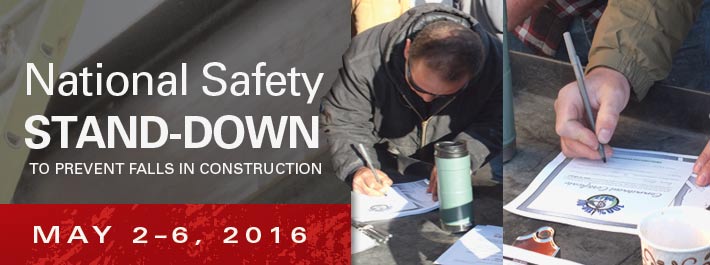
Although Centerline Solutions said that they participated during the stand-down with pledge commitments and other activities, as did two other companies, the majority of industry contractors did not join the national effort.
It will be a while before the Occupational Safety and Health Administration (OSHA) identifies how successful this year’s national safety stand-down was, but from an overview of wireless construction company participants, it received a weak effort.
However, that’s not to say that the wireless industry isn’t concerned about worker safety, especially preventing falls which accounted for 337 of the 874 construction recorded fatalities according to 2014 data from the Bureau of Labor Statistics.
One industry company with approximately 160 field personnel contacted by Wireless Estimator skipped the stand-down this year due to a “considerable backlog” of work that they had to complete.
Their environment, health and safety officer, who requested that his company name not be published, said, “I’d be troubled if OSHA or anyone else judged a company’s safety culture based upon their lack of participation. Our safety training is year ‘round and I don’t believe setting aside a set number of days provides any additional value. It seems more like an annual campaign by OSHA for them to champion how their efforts are helping to keep the workforce safe.”
Wireless Estimator put out a call to companies to provide details as to how they would be reinforcing the importance of fall protection, during the May 2, to May 6 stand-down, and 22 companies responded.
Unfortunately, only three replies identified participation.
Texas A&M Engineering Extension Service said, amongst other activities, they held free fall hazard awareness courses, and Fortune Wireless out of Indianapolis, Ind. participated in the stand-down by having all employees participate in mandatory inspections of all safety equipment, PPE, and harness inspections, along with a safety meeting.
Golden Colo.-based Centerline Solutions went full out during the week with tower techs signing a 100% tie-off pledge and all climbers receiving a commemorative coin to represent their tie-off commitment. Along with other company-wide commitments, the contractor, with approximately 420 employees, also committed to having its safety committee members visit various job sites with different members of the management team to reinforce the connection between all levels of the company and how safety is an important topic in all roles.
But 19 companies offered what they believed were valid reasons why they weren’t going to participate in the stand-down.
“We’ve been in business for 12 years and have not had any fatalities. Although we’ve had at least four people that fell while working on a tower, their PPE arrested their fall and they didn’t receive any serious injuries. That comes from having a solid safety culture backed by training and supervision. A couple of feel-good compliance courses can’t duplicate that,” said one company executive.
Another voiced a similar opinion, stating, “We’re a small company with four crews and safety has always been our top priority and we’re always training and focusing upon safety. To be politically correct I could take a day off and repeat the same frequent training that we provide, but I can assure you our customer would give us Brownie points, but no extra time to meet their schedule.”
OSHA’s goal was to reach 5 million workers. If OSHA meets that milestone, they will have touched more than half of the construction workers in the country. That count will double last year’s 2.5 million workers.
For some, the goal seemed overly ambitious, especially considering that the agency wanted to double the participation from 2015, but cut the participation period from two weeks to one.
For analysis of the 2014 and 2015 stand-downs by The Center for Construction Research & Training, click here.

















